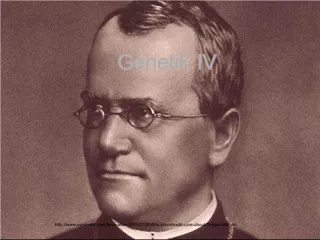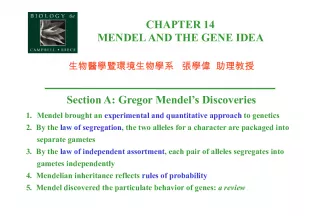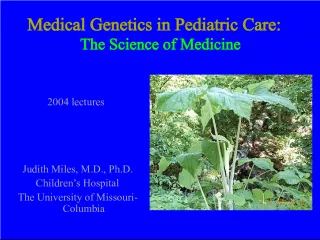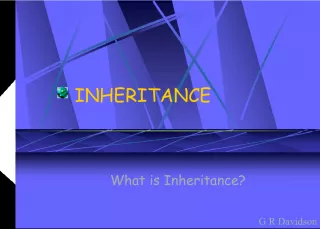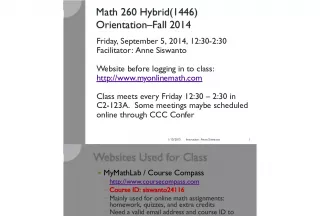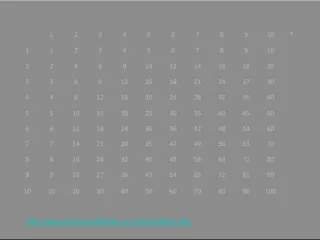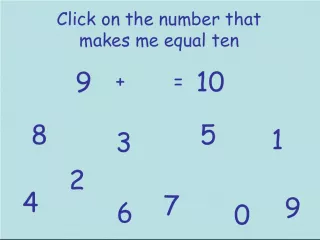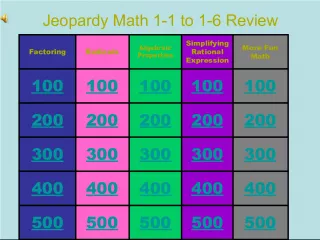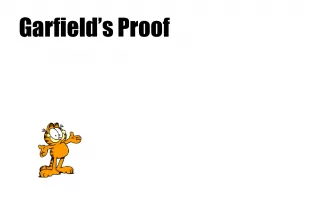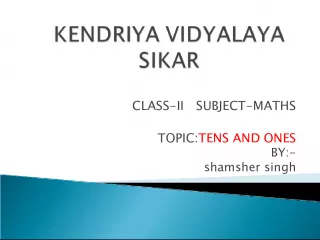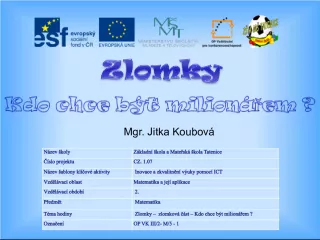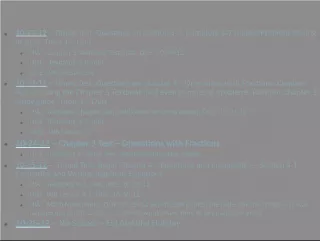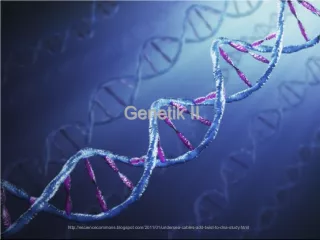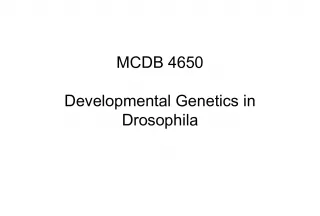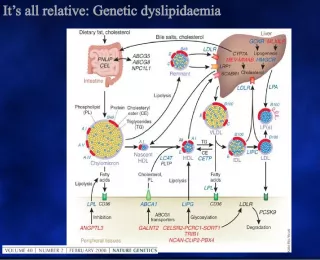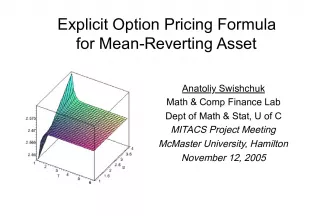Math of Genetics


Understanding how to find the probability of genetic traits through mathematical calculations. This course will be taught by Mary Simpson.
- Uploaded on | 3 Views
-
 roope
roope
About Math of Genetics
PowerPoint presentation about 'Math of Genetics'. This presentation describes the topic on Understanding how to find the probability of genetic traits through mathematical calculations. This course will be taught by Mary Simpson.. The key topics included in this slideshow are . Download this presentation absolutely free.
Presentation Transcript
1. Math of Genetics Math of Genetics Mary Simpson Mary Simpson MATH 150 MATH 150
2. Objectives Understanding how to find the probability of genetic outcomes for situations involving: Multiple Traits Linkage Incomplete Dominance Codominance Multiple Allelism Understanding Hardy Weinberg Equations in relation to population genetics
3. Flashback to High School Biology! Genetics: the study of the inheritance of traits Gene: a section of DNA that influences the heredity of a trait
4. Flashback to High School Biology! Genetics: the study of the inheritance of traits Gene: a section of DNA that influences the heredity of a trait Chromosome: dense coils of DNA that contain multiple genes Allele: denotes different versions of the same gene
5. Flashback to High School Biology! Genetics: the study of the inheritance of traits Gene: a section of DNA that influences the heredity of a trait Chromosome: dense coils of DNA that contain multiple genes Allele: denotes different versions of the same gene Gregor Mendel was a pioneer in genetics
6. Mendelian Genetics Gregor Mendel (1822- 1884) Studied the inheritance of traits in pea plants
7. Mendelian Genetics Gregor Mendel (1822- 1884) Studied the inheritance of traits in pea plants Mendel looked for patterns in the inheritance traits from parents with specified traits
8. How Genes Are Inherited The average human had 46 chromosomes (2 sets of 23)
9. How Genes Are Inherited The average human had 46 chromosomes (2 sets of 23) Half of these chromosomes come from the mother and half from the father (1 set from each parent)
10. How Genes Are Inherited The average human had 46 chromosomes (2 sets of 23) Half of these chromosomes come from the mother and half from the father (1 set from each parent) Because there are two sets of chromosomes, a person inherits two copies of each gene
11. How Genes Are Inherited The average human had 46 chromosomes (2 sets of 23) Half of these chromosomes come from the mother and half from the father (1 set from each parent) Because there are two sets of chromosomes, a person inherits two copies of each gene A person has two alleles for each trait that interact, resulting in the expressed trait
12. Inheritance of Single Traits Dominant Trait: if a gene for the dominant trait (called a dominant allele) is present, it will be expressed Usually expressed with an uppercase letter (ex. A) Recessive Trait: this trait will only be expressed in the absence of a dominant allele Usually expressed with a lowercase letter (ex. a)
13. Inheritance of Single Traits Dominant Trait: if a gene for the dominant trait (called a dominant allele) is present, it will be expressed Usually expressed with an uppercase letter (ex. A) Recessive Trait: this trait will only be expressed in the absence of a dominant allele Usually expressed with a lowercase letter (ex. a) Genotype: the combination of two alleles (ex. Aa) Phenotype: the trait expression that results from a genotype
14. Inheritance of Single Traits Dominant Trait: if a gene for the dominant trait (called a dominant allele) is present, it will be expressed Usually expressed with an uppercase letter (ex. A) Recessive Trait: this trait will only be expressed in the absence of a dominant allele Usually expressed with a lowercase letter (ex. a) Genotype: the combination of two alleles (ex. Aa) Phenotype: the trait expression that results from a genotype Homozygous: genotype with two copies of the same allele (ex. AA, aa) Heterozygous: genotype with one dominant allele and one recessive allele (ex. Aa)
15. Punnett Squares To form a punnett square, form a grid with the paternal genotype on the top and the maternal genotype down the left side
16. Punnett Squares To form a punnett square, form a grid with the paternal genotype on the top and the maternal genotype down the left side In the center sections of the table, combine the paternal and maternal alleles to create all possible genotypes for the offspring
17. Punnett Square Example If we have a mother with genotype aa and a father with genotype Aa The punnett square would look as follows: a a A a
18. Punnett Square Example If we have a mother with genotype aa and a father with genotype Aa The punnett square would look as follows: a a A A A a a a
19. Punnett Square Example If we have a mother with genotype aa and a father with genotype Aa The punnett square would look as follows: a a A A a A a a a a a a
20. Punnett Square Example If we have a mother with genotype aa and a father with genotype Aa The punnett square would look as follows: a a A A a A a a a a a a Genotypic Ratio : a ratio of the number of possible outcomes of each genotype (in this example 1:1 ) Phenotypic Ratio : ratio of the number of outcomes that will result in different phenotypes (in this example 1:1 )
21. Practice Problem The allele for dark hair (B) is dominant and the allele for light hair (b) is recessive If a female with genotype Bb and a male with genotype Bb mate, what are the chances that they will have a light haired offspring?
22. Practice Problem The allele for dark hair (B) is dominant and the allele for light hair (b) is recessive If a female with genotype Bb and a male with genotype Bb mate, what are the chances that they will have a light haired offspring? B b B b
23. Practice Problem The allele for dark hair (B) is dominant and the allele for light hair (b) is recessive If a female with genotype Bb and a male with genotype Bb mate, what are the chances that they will have a light haired offspring? B b B B B b b b
24. Practice Problem The allele for dark hair (B) is dominant and the allele for light hair (b) is recessive If a female with genotype Bb and a male with genotype Bb mate, what are the chances that they will have a light haired offspring? B b B B B B b b B b b b
25. Practice Problem The allele for dark hair (B) is dominant and the allele for light hair (b) is recessive If a female with genotype Bb and a male with genotype Bb mate, what are the chances that they will have a light haired offspring? B b B B B B b b B b b b To have light hair the genotype must be bb There is only a 1/4 chance of that, therefore the chance is 25%
26. Inheritance of Two Traits Looking at the inheritance of two traits is called a dihybrid cross
27. Inheritance of Two Traits Looking at the inheritance of two traits is called a dihybrid cross To set up the punnett square you have to look at all possible combinations of maternal and paternal DNA
28. Inheritance of Two Traits Looking at the inheritance of two traits is called a dihybrid cross To set up the punnett square you have to look at all possible combinations of maternal and paternal DNA You use those 4 combinations from each parent to set up the punnett square
29. Practice Problem We will look at the inheritance of brown and black fur and coarse and soft fur in hamsters Brown fur (B) and soft fur (S) are dominant
30. Practice Problem We will look at the inheritance of brown and black fur and coarse and soft fur in hamsters Brown fur (B) and soft fur (S) are dominant
31. Practice Problem We will look at the inheritance of brown and black fur and coarse and soft fur in hamsters Brown fur (B) and soft fur (S) are dominant If the mother has genotype BBss and the father has genotype BbSs , what is the chance that an offspring will have brown coarse fur?
32. Practice Problem Cont. If the mother has genotype Bbss and the father has genotype BbSs, what is the chance that an offspring will have brown coarse fur? BS Bs bS bs Bs Bs bs bs
33. Practice Problem Cont. If the mother has genotype Bbss and the father has genotype BbSs, what is the chance that an offspring will have brown coarse fur? BS Bs bS bs Bs Bs Bs Bs Bs Bs Bs Bs Bs Bs bs bs bs bs bs bs bs bs bs bs
34. Practice Problem Cont. If the mother has genotype Bbss and the father has genotype BbSs, what is the chance that an offspring will have brown coarse fur? BS Bs bS bs Bs B BS s B Bs s B bS s B bs s Bs B BS s B Bs s B bS s B bs s bs b BS s b Bs s b bS s b bs s bs b BS s b Bs s b bS s b bs s
35. Practice Problem Cont. If the mother has genotype Bbss and the father has genotype BbSs, what is the chance that an offspring will have brown coarse fur? Phenotypic Ratio 6:6:2:2 BS Bs bS bs Bs B BS s B Bs s B bS s B bs s Bs B BS s B Bs s B bS s B bs s bs b BS s b Bs s b bS s b bs s bs b BS s b Bs s b bS s b bs s
36. Practice Problem Cont. If the mother has genotype Bbss and the father has genotype BbSs, what is the chance that an offspring will have brown coarse fur? Phenotypic Ratio 6:6:2:2 BS Bs bS bs Bs B BS s B Bs s B bS s B bs s Bs B BS s B Bs s B bS s B bs s bs b BS s b Bs s b bS s b bs s bs b BS s b Bs s b bS s b bs s
37. Practice Problem Cont. If the mother has genotype Bbss and the father has genotype BbSs, what is the chance that an offspring will have brown coarse fur? Phenotypic Ratio 6:6:2:2 Out of the sixteen possible genetic combinations, 6 result in brown, coarse fur 6/16= .375 = 37.5% BS Bs bS bs Bs B BS s B Bs s B bS s B bs s Bs B BS s B Bs s B bS s B bs s bs b BS s b Bs s b bS s b bs s bs b BS s b Bs s b bS s b bs s
38. Linkage Linked genes are those found on the same chromosome
39. Linkage Linked genes are those found on the same chromosome This means that these traits should not follow the same pattern of inheritance because the traits cannot be independently assorted into gametes
40. Linkage Linked genes are those found on the same chromosome This means that these traits should not follow the same pattern of inheritance because the traits cannot be independently assorted into gametes In terms of a punnett square, having two linked traits would be treated like having a single trait
41. Linkage Linked genes are those found on the same chromosome This means that these traits should not follow the same pattern of inheritance because the traits cannot be independently assorted into gametes In terms of a punnett square, having two linked traits would be treated like having a single trait Mendel was lucky that each of the traits he studied had genes that were not linked
42. Incomplete Dominance Incomplete dominance means that the dominant allele will not completely dominant the recessive allele
43. Incomplete Dominance Incomplete dominance means that the dominant allele will not completely dominant the recessive allele In many cases this means that heterozygous individuals will have intermediate phenotypes
44. Incomplete Dominance Incomplete dominance means that the dominant allele will not completely dominant the recessive allele In many cases this means that heterozygous individuals will have intermediate phenotypes This will not alter genotypic ratios, but it will alter phenotypic ratios
45. Practice Problem The allele for white flowers (R) is dominant, but it’s dominance incomplete The allele for red flowers (r) is recessive
46. Practice Problem The allele for white flowers (R) is dominant, but it’s dominance incomplete The allele for red flowers (r) is recessive What are the possible phenotypes of the offspring of two plants with genotypes Rr and Rr?
47. Practice Problem The allele for white flowers (R) is dominant, but it’s dominance incomplete The allele for red flowers (r) is recessive What are the possible phenotypes of the offspring of two plants with genotypes Rr and Rr? R r R r
48. Practice Problem The allele for white flowers (R) is dominant, but it’s dominance incomplete The allele for red flowers (r) is recessive What are the possible phenotypes of the offspring of two plants with genotypes Rr and Rr? R r R RR Rr r Rr rr
49. Practice Problem The allele for white flowers (R) is dominant, but it’s dominance incomplete The allele for red flowers (r) is recessive What are the possible phenotypes of the offspring of two plants with genotypes Rr and Rr? R r R RR Rr r Rr rr RR will have white flowers rr will have red flowers Rr will have pink flowers (intermediate between white and red)
50. Practice Problem If we mated two of that same type of flowers with the genotypes, RR and Rr, what is the probability that the offspring will have pink flowers?
51. Practice Problem If we mated two of that same type of flowers with the genotypes, RR and Rr, what is the probability that the offspring will have pink flowers? R R R r
52. Practice Problem If we mated two of that same type of flowers with the genotypes, RR and Rr, what is the probability that the offspring will have pink flowers? R R R RR RR r Rr Rr
53. Practice Problem If we mated two of that same type of flowers with the genotypes, RR and Rr, what is the probability that the offspring will have pink flowers? R R R RR RR r Rr Rr 2/4 or 50% chance
54. Codominance Codominance: when heterozygotes have the phenotypes associated with each allele (because both alleles are dominant)
55. Codominance Codominance: when heterozygotes have the phenotypes associated with each allele (because both alleles are dominant) The best example is blood type There are three alleles for blood type (I A , I B , i)
56. Codominance Codominance: when heterozygotes have the phenotypes associated with each allele (because both alleles are dominant) The best example is blood type There are three alleles for blood type (I A , I B , i) I A and I B are codominant, so if a person has genotype I A I B , they will have type AB blood I A i, results in type A, I B i in type B and ii in type O
57. Practice Problem What are the possible blood types of offspring of parents with genotypes I A i and I B I B
58. Practice Problem What are the possible blood types of offspring of parents with genotypes I A i and I B I B I B I B I A i
59. Practice Problem What are the possible blood types of offspring of parents with genotypes I A i and I B I B I B I B I A I A I B I A I B i I B i I B i
60. Practice Problem What are the possible blood types of offspring of parents with genotypes I A i and I B I B I B I B I A I A I B I A I B i I B i I B i I A I B will result in type AB I B i will result in type B
61. Practice Problem What is the chance that a mother with genotype I B i and a father with genotype I A i will have a child with type O blood?
62. Practice Problem What is the chance that a mother with genotype I B i and a father with genotype I A i will have a child with type O blood? I B i I A i
63. Practice Problem What is the chance that a mother with genotype I B i and a father with genotype I A i will have a child with type O blood? I B i I A I A I B I A i i I B i ii
64. Practice Problem What is the chance that a mother with genotype I B i and a father with genotype I A i will have a child with type O blood? I B i I A I A I B I A i i I B i ii 1/4 or 25%
65. Multiple Gene Inheritance Multiple Gene Inheritance: there is more than one gene that controls the expression of a trait
66. Multiple Gene Inheritance Multiple Gene Inheritance: there is more than one gene that controls the expression of a trait Example: Pepper Color Pepper color is controlled by two different genes The first gene controls the expression of red pigment The dominant allele (R) indicates the presence of red pigment The recessive allele (r) indicates the absence of red pigment
67. Multiple Gene Inheritance Multiple Gene Inheritance: there is more than one gene that controls the expression of a trait Example: Pepper Color Pepper color is controlled by two different genes The first gene controls the expression of red pigment The dominant allele (R) indicates the presence of red pigment The recessive allele (r) indicates the absence of red pigment The second gene controls the expression of either green (G) or yellow (g) pigment
68. Multiple Gene Inheritance If red pigment is expressed, the pepper will be red, regardless of the second gene.
69. Multiple Gene Inheritance If red pigment is expressed, the pepper will be read, regardless of the second gene. If the red pigment is absent, you must look to the second gene to determine color
70. Multiple Gene Inheritance If red pigment is expressed, the pepper will be red, regardless of the second gene. If the red pigment is absent, you must look to the second gene to determine color What would the color of a pepper with the genotype Rrgg be?
71. Multiple Gene Inheritance If red pigment is expressed, the pepper will be read, regardless of the second gene. If the red pigment is absent, you must look to the second gene to determine color What would the color of a pepper with the genotype Rrgg be? Red
72. Multiple Gene Inheritance If red pigment is expressed, the pepper will be red, regardless of the second gene. If the red pigment is absent, you must look to the second gene to determine color What would the color of a pepper with the genotype Rrgg be? Red What about rrGg
73. Multiple Gene Inheritance If red pigment is expressed, the pepper will be read, regardless of the second gene. If the red pigment is absent, you must look to the second gene to determine color What would the color of a pepper with the genotype Rrgg be? Red What about rrGg Green
74. Hardy Weinberg Principle Looks at the frequency of alleles in a population The Principle makes several important assumptions: There is not natural selection regarding the gene in question There is no genetic drift There is no gene flow There is no mutation Random mating with respect to the gene in question is occurring
75. Hardy Weinberg Principle Hardy Weinberg Equation: p 2 + 2pq + q 2 = 1 p + q = 1
76. Hardy Weinberg Principle Hardy Weinberg Equation: p 2 + 2pq + q 2 = 1 p + q = 1 p=allele frequency of the dominant allele q=allele frequency of the recessive allele
77. Hardy Weinberg Principle Hardy Weinberg Equation: p 2 + 2pq + q 2 = 1 p + q = 1 p=allele frequency of the dominant allele q=decimal version of the recessive allele p 2 is the frequency of the homozygous dominant genotype q 2 is the frequency of the homozygous recessive genotype 2pq is the frequency of the heterozygous genotype
78. Genes that the Hardy Weinberg Equilibrium Applies To Tongue Rolling (dominant)
79. Genes that the Hardy Weinberg Equilibrium Applies To Tongue Rolling (dominant) Free (dominant) v. Attached (recessive) Earlobes
80. Genes that the Hardy Weinberg Equilibrium Applies To Tongue Rolling (dominant) Free (dominant) v. Attached (recessive) Earlobes Hand Clasping Left thumb over right (dominant) Right thumb over left (recessive)
81. Genes that the Hardy Weinberg Equilibrium Applies To Tongue Rolling (dominant) Free (dominant) v. Attached (recessive) Earlobes Hand Clasping Left thumb over right (dominant) Right thumb over left (recessive) Widow’s Peak (dominant)
82. Genes that the Hardy Weinberg Equilibrium Applies To Tongue Rolling (dominant) Free (dominant) v. Attached (recessive) Earlobes Hand Clasping Left thumb over right (dominant) Right thumb over left (recessive) Widow’s Peak (dominant) Mid-Digital Hair (dominant)
83. Using the Hardy Weinberg Equations If the frequency of the recessive allele for sickle cell anemia is .4 in a population of 100,000 The dominant allele has a frequency of .6 Individuals that are heterozygous for this allele have a higher resistance to malaria How many members of the population would have the increased resistance to malaria?
84. Using the Hardy Weinberg Equations If the frequency of the recessive allele for sickle cell anemia is .4 in a population of 100,000 people The dominant allele has a frequency of .6 How many members of the population would have the increased resistance to malaria? Heterozygous Frequency = 2pq
85. Using the Hardy Weinberg Equations If the frequency of the recessive allele for sickle cell anemia is .4 in a population of 100,000 people The dominant allele has a frequency of .6 How many members of the population would have the increased resistance to malaria? Heterozygous Frequency = 2pq 2pq = 2 * 0.4 * 0.6 = .48
86. Using the Hardy Weinberg Equations If the frequency of the recessive allele for sickle cell anemia is .4 in a population of 100,000 people The dominant allele has a frequency of .6 How many members of the population would have the increased resistance to malaria? Heterozygous Frequency = 2pq 2pq = 2 * 0.4 * 0.6 = .48 48,000 people would have increased malaria resistance
87. Homework 1. What is the probability that a father with genotype Hhpp and a mother with genotype HHPp will have offspring that have the dominant phenotype for both traits? 2. If the allele frequency for blue eyes in a population is 0.35 and that allele is recessive, what is the frequency of heterozygous individuals in the population?
